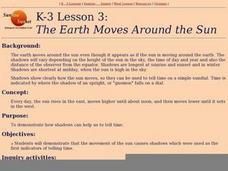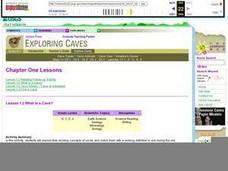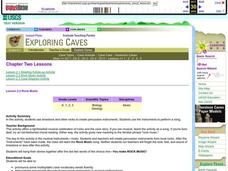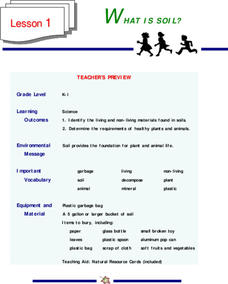Curated OER
What Is An Insect?
Learners find and classify insects. They collect insects, study them with a hand lens and identify its body parts. Afterwards, they discus various types of insects and thier Orders such as beetles, butterflies and moths, grasshoppers, etc.
Curated OER
Palo Verde Identification Key
Students explore a key with characteristics to distinguish between the four Palo Verde trees in Arizona.
Curated OER
Birds, Birds, Birds
Students explore one bird a day and eventually put together a book about each of the birds they learn.
Curated OER
Pre-School
Young scholars draw their hand, and color their drawing. They count the number of fingure on thier hand. Students count the number of arms on the marine animal in the picture. They count the number of legs and claws on the marine animal...
Curated OER
The Earth Moves Around the Sun
Students demonstrate that the movement of the sun causes shadows which were used as the first indicators of telling time.
Curated OER
Solar Eclipse
Learners demonstrate the revolution of the moon around the earth and the effect of its direct alignment in between the earth and the sun.
Curated OER
Planting Wheat with Little Red Hen
Students discuss the cycle of growing wheat, and then plant their own in foil pans. After the wheat grows for a couple of weeks, students participate in a story retelling activity reinforcing the concepts of the process.
Curated OER
Insects Word Wall
In this vocabulary worksheet, students analyze 40 word and picture cards to learn the names of common insects. One set is in color, the other is black and white. These cards are intended to be used on a word wall.
Curated OER
Dinosaur Names Mix And Match
In this vocabulary worksheet, students examine pictures of 16 dinosaurs and learn their names. Students study the word and picture cards. There are no directions but these could be cut apart for a matching game or used on a word wall.
Curated OER
Scientists Write!
Students use a journal to record observations. They make notes about what research may be needed to answer questions that have come up in the field and sketch or make connections in the curriculum. They research bioinformatics and...
Curated OER
The Five Senses
Students participate in a scavenger hunt using their sense of sight. They bring various texture materials from home and discuss how things feel. Students identify the smells inside five jars. They discuss things they hear and why hearing...
Curated OER
Exploring Caves
Learners explain why many caves have become National Parks. They determine that caves provide shelter from enemies, and from bad weather in the summer or the winter, and provide certain mineral resources. They discover that ancient art...
Curated OER
Exploring Caves
Students explore the various characteristics of caves. Through class discussion and hands on activities, students identify what forces converge in the creation of a cave. They complete review activities at the conclusion of the lesson....
Curated OER
What Is A Cave?
Students explore their existing concepts of caves and match them with a working definition to use during the unit. They name the two types of rock formations in which most American caves occur, and define "show cave" and "wild cave."
Curated OER
Rock Music
Pupils create percussion instruments using limestone and other rocks. They use instruments to perform a song.
Curated OER
Adapting to the Dark-Bats and People
Students consider how cavers make adaptations to the cave as do bats.
Curated OER
Affecting Transportation Choices-Walk, Don't Ride!
Students discuss methods of transportation they use and create a trip tally to determine which methods they use the most.
Curated OER
Air, Air-It's Everywhere!
Students engage in experiment activities, which illustrate that air is made of matter, does take up space, and is very important to our health. This instructional activity contains activities for a variety of grade levels. A very nice idea!
Curated OER
To Rot or Not!
Learners discover that composting helps reduce landfill waste and is good for the soil. They explore the techniques of composting through a variety of media, art activities and hands-on experience.
Curated OER
What is Soil?
Students study living and non-living materials that are found in soil. They study the things required by plants and animals to remain healthy. They design a collage of sand, stones, leaves and other natural items.
Curated OER
Reading Research!
Students investigate the life of an animal and how it responds to winter. The instructional activity's focus is on reading and research skills using pictures to assist in the understanding of the information presented.
Curated OER
Follow the Water Cycle
Students explore the stages in the water cycle, evaporation, condensation, and precipitation. They hypothesize about the source of rain and search for forms of water on Earth.
Curated OER
What on Earth is in the Earth?
Students explore the physical properties of sand, soil, and rocks and sort, classify, compare, and contrast the materials found in the soil. The differences between the living and non-living parts of the soil is discussed.
Curated OER
Tall as a Mountain, Flat as a Plain
Students examine a variety of landforms that are found on the Earth and compare and contrast the distinguishing qualities of these forms. A topographical model of the landforms is made.

























